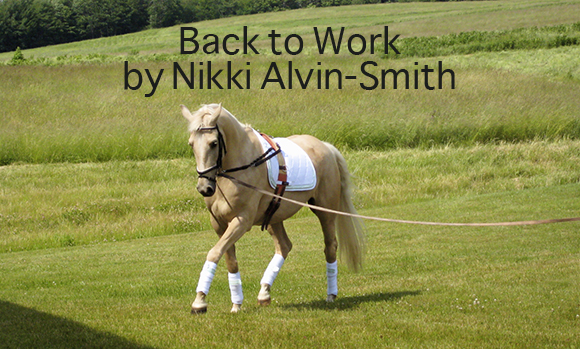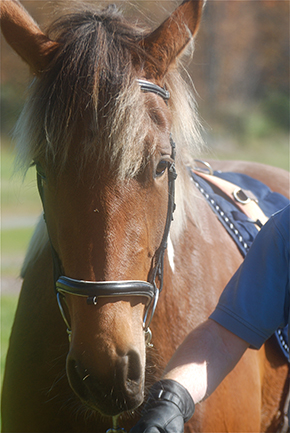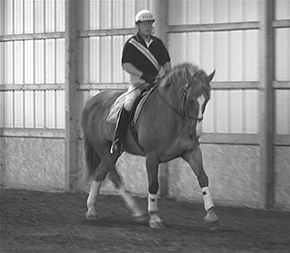Back to Work
By Nikki Alvin-Smith

Winter is in the rear view mirror and your horse has enjoyed a hiatus from ridden work and appears to be fat, fluffy and full of beans. The blanket ‘reveal’ shows his beautiful musculature from last season has evaporated or at least subsided to the underside of his belly. You may have been ignoring the fact during pajama switches throughout the winter season but now you must face reality. Your horse is out of condition. And quite possibly so are you. Here are a few tips to get you back on track. If your horse has been out of work due to a medical issue always seek the advice of your vet as to how much work and what work it is safe to do with your horse. I will address this more specifically later in the article.
Begin by giving him a thorough groom, which will not only ready him for a workout but also give you an opportunity to check for bumps, bruises, swellings or coat condition issues. Be certain as you work that you are quietly assertive with your requests and that you insist he mind his manners. His hooves should be recently trimmed or re-shod, and his teeth floated and vaccinations scheduled.
 To leg him up work on the longe line is a great place to start as it gives you the opportunity to evaluate his soundness and to remind your horse that you are in charge. It will also allow his back muscles to rebuild without the weight of the rider. The use of side reins is important as you want him to stretch down and develop his topline. As your horse may be unusually rambunctious with the excitement of coming back to work protective boots are a good idea. You don’t want your horse to pull a ligament or tear a tendon or knock himself and set you back in your training program.
To leg him up work on the longe line is a great place to start as it gives you the opportunity to evaluate his soundness and to remind your horse that you are in charge. It will also allow his back muscles to rebuild without the weight of the rider. The use of side reins is important as you want him to stretch down and develop his topline. As your horse may be unusually rambunctious with the excitement of coming back to work protective boots are a good idea. You don’t want your horse to pull a ligament or tear a tendon or knock himself and set you back in your training program.
The sessions should begin with 10 to 15 minutes on each rein and start out with mainly walk and trot with lots of transitions. These transitions will build the muscles back quickly. Muscles have memory and a horse that was fit before his hiatus will recover his strength much more quickly than a horse that has never been fit. Keep a keen eye on the breathing of your horse. If the nostrils are flared or even inflamed then he needs a walk break. Gradually add in the canter work.
You should treat your horse as an individual and use your common sense as to how many times a week he can handle. You may start with 3 or 4 times a week for a younger horse. In my experience you are building back the mental strength of your horse as well as his physical strength. In general a young horse will need time between sessions to think about his lesson and develop his focus, while an older horse will slip back into the program much more readily. I also try to turn the horse out between sessions as much as possible so he can walk off any angst or lactic acid build up.
Before you saddle up and return to ridden work do a saddle fit check as due to the lack of work your horse may still have a lack of muscle on his back compared to how he finished out last season. You may be able to add a sheepskin saddle pad as a temporary fix or other saddle pad. There are many therapeutic saddle pad options on the market you can explore. If your horse is younger he may have developed a higher wither, or grown in general requiring a saddle fitter’s attention. Saddle fitters will usually come out for $130-$180 a visit and are well worth the money. An ill-fitting piece of tack will cause much more expensive soundness problems down the trail and will impair your training progress.
Before mounting your horse after a long break you may want to longe your horse in, to work out any extra exuberance before you ride. Prudence is never a wasted notion. Safety first.
Now you are back on top start as you mean to go on. As a clinician I am always training students to think about every stride from the moment they mount. Yes the horse can walk out in a relaxed manner but he must walk on. The minute you gently lower yourself in the saddle your horse should pay attention and be in front of your leg and active in his gaits. Your horse should maintain this level of attentiveness and activity until the moment you dismount. Every stride your horse makes is either a building stride or a breakdown stride, so make every one count.
Start out with twenty-meter circles and figure eights. This will keep your horse’s attention and encourage you to use your legs properly. After all, you may be rusty too. If you have not been active in other sports or activities during the hiatus allow yourself some time to become fit also. In the event the hiatus was caused by an accident you encountered with your horse you should allow that you may experience some rider anxiety. If you are concerned for your well-being then have a more accomplished equestrian ride the horse in for you if possible. Even very accomplished professional riders can have sincere anxiety for those first rides after a major mishap. You should set small attainable goals to overcome any anxiety. Remember that slow and steady is the best way forward. Little and often is better than infrequent long rides for both you and your horse.
As with the longe work use frequent transitions to engage your horse on his hind end and keep his attention. You can begin walk and trot and then add a canter. Be certain to work your horse evenly on both sides. If your horse is not listening and running through the tack or leaning on your hands then bring him back to a calm halt and then start over. You will have the most control on the circle so if you are riding the whole arena and your horse starts to act up just head back to the circle. With diagonal work and rein changes start on short diagonals with a downward transition in the middle and back up a few strides later.
Canter work will bring up the belly line the fastest, given that it is correctly done and the horse bascules over his back and is not hollow. It is better to do short sets interspersed with trot work and if your horse is able add some lateral work in to the sessions at the walk and trot to encourage your horse to use his sacroiliac muscles. Flexion of the horse longitudinally and laterally will develop him quickly. This is the best form of gymnastic training you can give your horse and lateral exercises where you switch halfway down the long side from shoulder in to renvers or travers are very good for releasing tension in the sacroiliac area.
As I am a big believer in the keeping the horse’s attitude fresh and happy once we have established the ‘ground rules’ in the arena I reward the horse by taking him out on the trails and fields. As he is now fit enough a good canter and ‘blow out’ of the pipes is an exhilarating and productive thing to do. I also find that too much schooling in an arena will not just make ‘Jack a very dull boy’ but myself a very dull girl. The Spring is such a pretty time of year and riding through the glade with the sun hitting the bright green sprigs of grass and leaves just starting to unfurl is such a joy.
Saddle work will be more tiring on your horse than longe work and certainly more tiring on you so start out with 20 -30 minute sessions and gradually increase the time frame. I have found some horses will switch off after 20 minutes and figure they should be finished with the lesson. Perhaps because they are on the longe for shorter periods and their body clock feels this is enough or perhaps it is a focus issue coming back to work. This is particularly true for some reason with mares. This point must be ridden through. Always ride when you have plenty of time so that you do not leave a lesson unfinished unless you decide it is better to come back another day.
Set a goal for each lesson as you go. There is a saying that for every week a horse is out of work it’ll take a week to bring him back to work. However, I have found that within six weeks of working the horse correctly he will be back in good form.
Growing up in England I would regularly help the neighbor leg up their horses in the summer for the foxhunting season. This involved a lot of road work. Miles and miles of trotting on tarmac which was believed to build bone strength. I would not advocate this as a route to leg up a horse today. It is better to work on interval training, add in trail and hills with a slight incline to provide a cardiovascular work out.
As you progress through the training time you will need to address the change in workload for your horse in regard to his nutritional needs. His diet will need to have sufficient protein so he can build muscle. It is a good idea to have a quick blood work up done during the Spring vaccination visit by your vet so that you can address any shortage in his diet such as common issues of selenium deficiencies.
Back to Work After Illness or Injury
Each medical situation will require a very individualized back to work program. The first rule is be diligent and follow the instructions of your vet for what kind of work and how much. If you have access to therapeutic options such as swimming pools, licensed massage/acupuncture therapists etc. then it is wise to utilize what is recommended for the well being of the horse. However, financially this is simply not always a viable option. Rehabilitation can be a long road but it can be a very positive one for you and your horse. Nothing creates a better bond. You can learn how to give many massage treatments, shiatsu treatments and other alternative treatments yourself but always seek the advice of your vet before tasking your horse.
It may be that you start the horse back to work by ponying him to recondition him bareback or this may not be viable or recommended and instead you start by hopping on board. Always start back by work on the flat not on any inclines.
If your horse has experienced a colic surgery then once you have the green light to go back to work the sessions will be short and sweet and will naturally begin with short sessions of walking. It may take six or seven weeks of daily walking sessions before you are given the go ahead to add trotting. The trot sessions will start at just five minutes at a time and gradually increase. After a few weeks of this trot work you may be able to add canter work. Before you know it you will be back to full time work.
For ligament and tendon injuries your work will begin similarly and will begin on straight lines only. Your vet will continue to monitor your horse’s recovery alongside your training program and his diagnostic tools will be invaluable in being certain you are not going too fast with the rehabilitation.
If you horse has suffered with a bout of laminitis then the return to work will be similar. Slow and steady is the way forward.
Whatever the issue keep heart that all will be well. I have known many horses that have suffered a serious injury at the beginning of their careers and yet go on to the top levels in their discipline.
 Yes, your horse may be exuberant to be back at work and do something daft and possibly re-injure himself but it is unlikely and there is every chance it can be recovered. You can ask your vet about sedation options although personally I would rather have my horse be 100% mentally with me than sidelined with a few cc’s of Acepromazine.
Yes, your horse may be exuberant to be back at work and do something daft and possibly re-injure himself but it is unlikely and there is every chance it can be recovered. You can ask your vet about sedation options although personally I would rather have my horse be 100% mentally with me than sidelined with a few cc’s of Acepromazine.
Always keep a good eye on your horse for stiffness, behavioral changes such as going off his food, not wishing to be touched or any other signs that may indicate discomfort and discuss with your vet. As with ourselves recovery may involve some level of pain but horses of course cannot speak. Do not rush to medicate especially for tendon/ligament recoveries as a little pain can be a good thing as the horse will not overuse the limb. The use of a heart monitor for your horse during rehabilitation can be extremely useful as you can learn how to detect fatigue or pain.
Always keep a positive attitude with your horse and surround yourself with positive people. Do not be afraid to ask for help or advice at any time from those you trust. Whether you or your horse is in recovery or both, the support of others can bring much relief and give you the impetus you need to keep going. As I constantly say to our students, “ When training your horse time is your friend not your enemy.” There is no need to rush. Indeed, the results will be better if you do not. Life is short. Live each moment.
Happy Riding!


